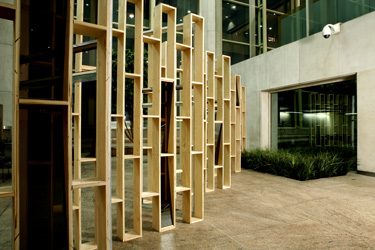Born 1970 in New Haven, Connecticut; lives in New York, New York
One might initially mistake Heather Rowe’s Entrance ( for some sites in dispute) (2007) for an unfinished part of the room in which it is installed: the series of plywood posts, manufacturer’s marks visible, could be faced in plasterboard and serve as the foundation or support for a wall. But discordant details soon emerge: shards of mirror wedged between Sheetrock painted bright crimson, fragments of white molding nestled into the lower ends of the wooden frames. Straddling the fault lines of sculpture, architecture, and installation, Rowe’s work fails to slot comfortably into any one of these categories and finds its force instead in the friction between media and the spaces they occupy.
Rowe’s materials are the raw supplies and castoffs of architecture—drywall, 2x4 beams, wood, and metal— which she combines with more decorative elements including ornamental frames, expanses of shag carpet, mirrors, wallpaper, and molding. Her forms evoke walls, windows, doors, and passageways, their emphasis on interstitial space traceable to 1960s and 1970s precedents such as Bruce Nauman’s corridor installations, Gordon Matta-Clark’s building cuts, and Robert Smithson’s mirror displacements. Yet the animating tension in Rowe’s work, tugging between public and private, is resolutely contemporary: negotiating one of her sculptures, in part as a result of its mirrored components, necessitates not only adjusting one’s sense of surround but also one’s awareness of others.
This awareness is not always comfortable; Rowe’s seemingly intuitive gift for balance and proportion is punctuated occasionally by hints of menace. The Stationmaster’s Wife (2005) comprises a found metal door, a one-way mirror, a set of windowlike casings, silver insulation, and, jutting out from the oddly exquisite arrangement, the fanciful frame and legs of a coffee table. From the top of the structure, however, hang two blades of mirrored glass. Their sharp points, like the eye-level shard in Green Desert (2006) and the cragged mirror edges in various of Rowe’s sculptures, complicate the work’s formal harmony and extend a subtle, yet nagging, proposition: that the impulse to turn the inside outside is always accompanied by a degree of risk. LISA TURVEY
Heather Rowe, Screen (for the rooms behind), 2007 (installation view, Whitney Museum of American Art at Altria, New York, 2007). Wood, mirror, linoleum tiles, ceiling tiles, metal studs, drywall, grass, and artificial grass, approximately 96 x 420 x 50 in. (244 x 1,067 x 127 cm). Collection of the artist
























